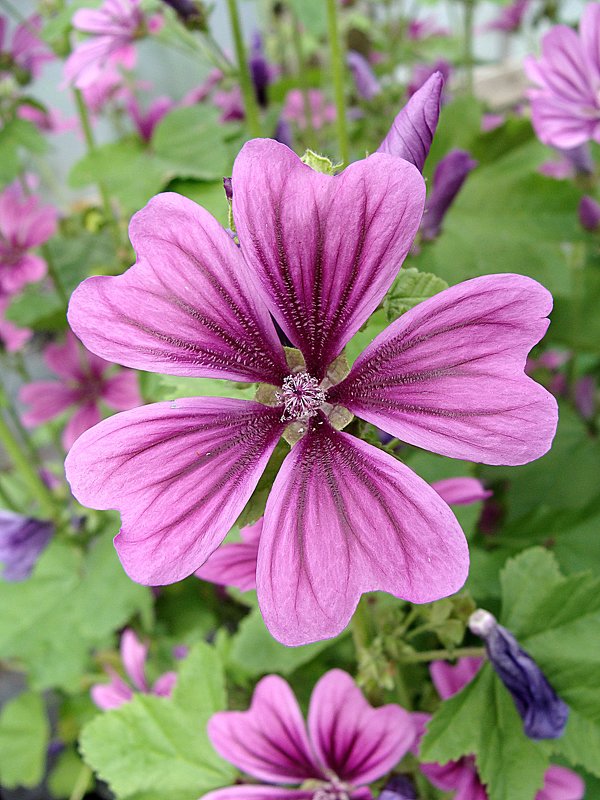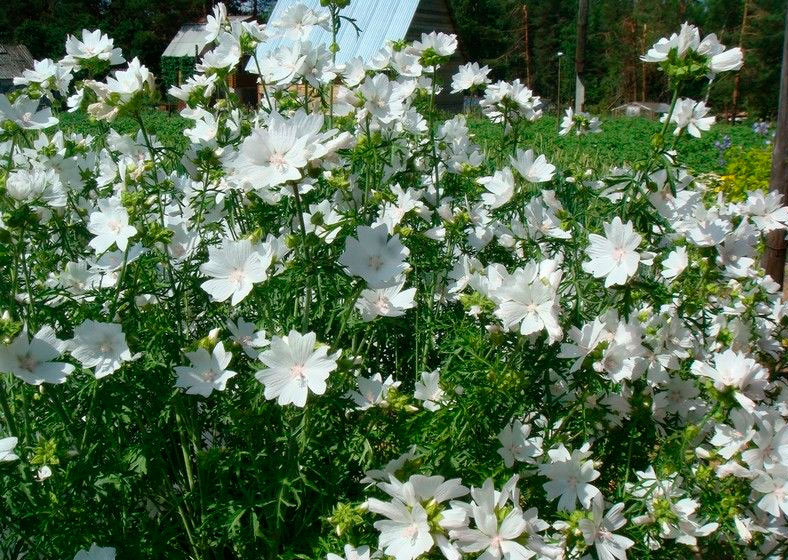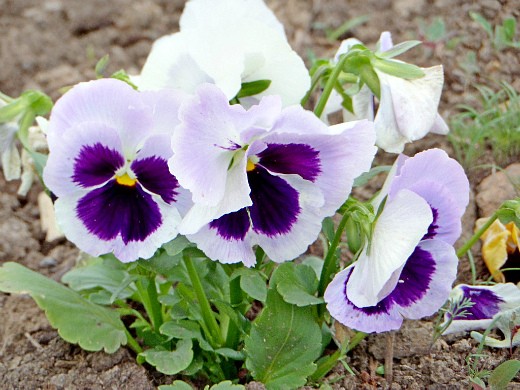Calmia care
The root system of the shrub is shallow and consists of very thin roots that are sensitive to damage, and the number of shoots and the abundance of flowering depends on the good condition of the roots.
Therefore, loosening and weeding around the bush should be done carefully.
In caring for kalmia, it is very important to maintain constant soil moisture, since the plant does not tolerate drought. Due to the shallow root system, sensitivity to moisture deficiency increases
The irrigation regime should take into account the weather conditions - they do not irrigate in the rains, and in the dry season they water often and abundantly. To reduce water evaporation and soil overheating, it is recommended to mulch the soil around the plantations with tree bark, dry needles or chips.
Mulching a Calmia seedling
Young kalmia seedlings are not hardy enough and require protection in severe winters. The bushes are covered with agrotextile and the space near the trunk is covered with a high layer of earth, compost or needles. In regions with mild winters, a layer of snow is sufficient.
The shrub is fed with mineral fertilizers for acidophilic crops. Half the dose recommended by the manufacturer is sufficient for the plant. They begin to feed in April with a frequency of once every 2-3 weeks. The last feeding should be no later than July.
From organic matter, humus or compost is suitable, which is scattered in the spring in the near-trunk area. After flowering, it is recommended to do light pruning by shortening the tops of the shoots.
Propagation of broadleaf Calmia by seeds
For germination, seeds require cold stratification at a temperature of 1-3 С. The planting material is mixed with wet sphagnum moss or peat and placed in a plastic bag or container in the refrigerator for 8 weeks. The material should not dry out.
Variety "Little Linda"
After the time has elapsed, the seeds are sown in pots filled with a mixture of peat and sand (2: 1). A layer of sphagnum moss or vermiculite is laid on top of the substrate, which helps to maintain moisture. Seed material is germinated at a temperature of 21-22 С.
Seeds, and then seedlings, require constant air and soil moisture. Such conditions can be provided with a cover made of a bag, glass or plastic.
Saplings from the seeds of "Little Linda"
Cover once a day is removed for 5-10 minutes for airing. Germination takes about 30 days, but seedlings grow very slowly, so the first flowering can only be expected after 6-7 years.
When the seedlings reach 5 cm in height, they are dived and planted in a fertile substrate based on universal soil and peat. A month later, they are transplanted into open ground by the transshipment method.
Propagation by cuttings
Broadleaf salsa can also be propagated vegetatively using the green top cuttings of the current year's shoots. In an amateur setting, however, this is extremely difficult, since the cuttings are difficult to root, but you can try if you want.
The cut of the cuttings is dipped into a powder that stimulates root formation and planted in a substrate prepared from equal parts of perlite, coarse sand and peat. For rooting, greenhouse conditions with constant humidity are required, which can be provided by a cover from a transparent bag.
The container with cuttings is placed in a place with diffused light during rooting. The root formation process can take four to six months. The saplings are harvested when signs of new growth appear, but the soil and seedling are regularly sprayed.
"Olympic flame"
The container is placed in a brighter place, exposed to morning or afternoon rays. In winter, they are kept in cool conditions, and planted in open ground in the spring, after the last frost.
Application in the garden
In the garden, broadleaf kalmia looks great in composition with hosts, ferns, azaleas, hydrangeas, rhododendrons and decorative deciduous shrubs (barberry, euonymus, derain, etc.). Small varieties of plants are ideal for decorating alpine slides and small bodies of water.
The shrub feels good in the diffused light of tall trees, it is often planted in the company of conifers. However, it is not recommended to plant the plant next to spruce trees, which impede the development of calmia roots.
Common varieties
 |
Forest mallow (Malva sylvestris)
|
 |
Sudanese mallow
‘));
|
 |
Musk mallow (Malva moschata)
|
 |
Wrinkled mallow (Malva alcea)
This type is combined with a stem of a rose with, as it were, corrugated petals on flowers:
|
 |
Malva hybrid (Malva hybrida) This species contains artificially bred hybrids that did not have a place in the previous species:
|
Growing and caring for flower biennials
The testes of biennial flowering plants should be grown on a high agricultural background, which will meet the requirements for each crop. This contributes to the manifestation of the decorative qualities of the varieties and abundant flowering.
Due to poor soil conditions and lack of water, plants degenerate. Seeds from such plants do not produce full-fledged offspring.
Like many other plants, excessive application of nitrogen fertilizers causes intensified development of vegetative parts in biennials due to the formation of seeds. To avoid this, you should not exceed the rate of nitrogen fertilizers, and give them more phosphorus during the budding period.
Care for seed producers is common: timely weeding, loosening, feeding, pest and disease control.

In some biennials (foxglove, Turkish carnation, grenadine carnation), side shoots are pinched in order to obtain large fruits and to accelerate seed ripening. To obtain high-quality pure-grade seeds, we select the best plants typical for the given variety. We discard the rest as it blooms. When 75 percent of the plants bloom, we perform a full varietal cleaning, removing all atypical, underdeveloped and diseased ones.
We establish the varietal qualities of the plants that remain, and after that we start collecting seeds. We collect seeds from most biennials gradually, as they ripen. For flowers with fruits that are cracking, for example, for brothers, we collect the fruits (boxes) unripe, dry them indoors, covering them with paper on top so that the seeds do not scatter. In daisies, ripe seeds fall off very quickly, so they must be collected immediately. For forget-me-not, night violet, lunar, jaundice, a ripe plant, as a rule, is cut off after the seeds have ripened, and then dried and threshed.
We cut off the fruits of the Turkish carnation and grenadine, as well as the bells, and then dry them indoors and thresh them in the same place. We store flower seeds, keeping the temperature not higher than 10-12 degrees, avoiding sudden temperature changes. Excessive dryness of the air, like excessive humidity, negatively affects the viability of the seeds.

Zinnia care in the garden
Taking care of your garden cinnamon is easy enough. Plantings need only be weeded in a timely manner, loosened the soil surface on the site, and also water abundantly, and this must be done at the root, since liquid should be excluded from the flowers. After the bushes bloom, they should be regularly examined in order to timely remove the flowers that have begun to fade. Zinnia's shoots are very strong, so there is no need to install a support or to tie them up.
Top dressing
After the seedlings appear and until planting in open soil, you need to make 3 fertilizing with mineral fertilizers with a low nitrogen content. The bushes planted in the garden are fed with liquid manure or mineral fertilizers at least 2 times during the summer months. So, the first time the bushes need to be fed 4 weeks after they are planted in open soil, and the second procedure is carried out during the formation of buds.
How to pinch zinnia
Many gardeners do not know for sure whether zinnia needs to be pinched, and if so, when should this procedure be carried out? A pinch of zinnia is done so that the bush is more lush and beautiful. You can pinch it at the stage of growing seedlings or after the bushes have taken root after they are planted in open ground. To do this, pinch the plant over 3 or 4 leaf plates. If this procedure is not carried out, then you will grow spectacular flowers on long peduncles, which are very good at cutting.
Zinnia pests
Most often, this plant is harmed by May beetles, slugs, aphids and snails. To get rid of gastropods, it is recommended to use traps, so bowls placed in several places on the site that need to be filled with beer are perfect for this, as well as pieces of roofing material and slate scattered between the bushes, since it is under them that such pests are most often hiding. They are collected exclusively by hand. The annoying May beetles must also be hand picked and placed in a bucket filled with soapy water.
If aphids have settled on a bush, then to destroy it, it is necessary to use a solution of tar soap (for 1 bucket of water 100 grams), which is used to process them. If there are a lot of pests, then Actellik or Fufanon solution can be used to destroy them, in the manufacture of which you must follow the instructions.
Diseases of zinnia
Zinnia is most susceptible to diseases such as: fusarium, gray rot, bacterial spotting. However, she is especially sick with powdery mildew.
Examine the bush. If you find at least one leaf plate on the surface of which there are brown-gray round specks, then this means that the plant is affected by bacterial spot. This disease is incurable. If the infection is not severe, then you can simply try to tear off all the affected leaf plates.If the disease is already running, then the bush should be dug up and burned as soon as possible.
For the treatment of powdery mildew (a whitish loose bloom forms on the surface of the bush), and also fusarium and gray rot, fungicidal preparations are used, for example: Fundazod or Topsin-M. Bushes affected by powdery mildew are recommended to be sprayed with Skor, Topaz or Topsin.
As a rule, zinnia gets sick due to the fact that the rules for caring for it have been violated. For example, the development of the disease can occur due to too abundant watering or overly dense planting. In this regard, when a disease appears, you must first understand what could have provoked its development. Then you need to try to eliminate all the existing violations in the care of such flowers, and then proceed to direct treatment. This will help prevent similar problems in the future.
How to store
There are two ways to save the plant until spring:
- in boxes or boxes;
- in flower pots.
If the first option was chosen, then before digging up it is necessary to prepare the soil: mix peat, sand and sawdust in equal amounts. After removing the rhizomes from the ground and drying, they are placed in containers, sprinkled with soil and, if necessary, slightly moistened. The best storage temperature is + 8-10 ºC.
With the second storage option, you can simultaneously save flowers until spring and enjoy their appearance in winter at home. The main thing is to have time to dig them up before the onset of frost. Care during this period is slightly different. Cannes should be placed in a lighted place, fed and watered.
If several varieties of canna are put into storage at the same time, it is recommended to attach a tag with its name to each rhizome. This technique will help in the spring when planting to create a unique composition, taking into account the characteristics of each variety.
To grow a flower, it is important for him to create conditions close to his relatives. In summer, it is warm and abundant in moisture, in winter, moderate watering and coolness.
The florist's reward for anxious and proper care and patience will be a healthy and strong appearance of the plant, abundant flowering.
Canna (lat. Canna) is a monotypic genus of the Cannaceae family, the order of gingerbread, has more than 50 species of herbaceous plants. The natural habitat is South America, India, China. Introduced to Europe in the 16th century by Portuguese sailors, but cultivated since the middle of the 17th century. Translated from Greek, the name of the flower means "reed". Indeed, the canna stem is similar to this plant.
The name is translated from Latin as "pipe". An ancient legend says that Cannes grew up on the site of the ashes of a fire in which one Indian chief burned a peace treaty rolled into a wampum - a pipe, which led to a bloody war, and the bright red petals of cannes resemble the flames of that fire and spilled in a cruel war blood. Flower growers appreciate cannes due to its beautiful flowering, large decorative leaves, painted in a dark green, dark purple, red-bronze or even purple hue.
At first glance, it may seem that the canna is an incredible hybrid of a banana and gladiolus or an orchid. The plant has only two drawbacks: in our climate, wintering in the open field is problematic and the flower has no aroma. For the rest - only dignity. Cannes practically do not get sick, are unpretentious, drought-resistant, even beginner growers can cope with them. Cannes will decorate your garden without any hassle, and bloom will last from the end of June until the first frost.
Brief botanical description
 Mallow flowers are usually single-row, semi-double and double varieties are the result of selection.
Mallow flowers are usually single-row, semi-double and double varieties are the result of selection.
- Name. Malva (Malva), in the scientific world is called the stock a rose, in addition, in every corner of the planet this flower has its own, folk names, only in Russia there are more than 10. Where mallow originated is not known for certain, mentions of it are found in ancient Greece, Egypt and in the writings of the Maya Indians.
- What it refers to. Mallow - this is one of the directions of the stock of roses combined and bred into a separate family of malvaceae. According to data from various sources, the family includes from 30 to 60 varieties.
- Height. As befits the stem of a rose, mallows have 1 straight stem, the height of which, depending on the variety, ranges from 30 cm to 2 meters. The leaves of the mallow are round, at the ground are large, higher along the trunk, the size of the leaf decreases.
- Bloom. The flowers are large, they are single-row, semi-double and double, the tinting is different. Pedicels are short, so the flowers seem to stick around the central trunk, the diameter ranges from 6 to 12 cm. The period of flowering of mallow is from July to October.
- Reproduction. After flowering, boxes about 3 cm in size with seeds are formed on the pedicel, which eventually burst and the rose self-sows. Mallow propagates only by seeds, from which seedlings are grown or planted immediately in open ground. The root system is stem, it can go up to 3 m deep.


